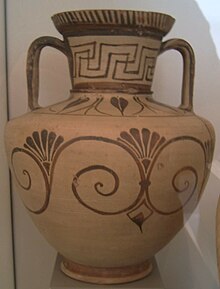Ficellura

As Fikellura refers to a genus ostgriechischer vases of Greek vase painting .
Fikellura pottery is named after a necropolis on Rhodes , where the first examples of these vases were found. They have a whitish coating and the figures shown are mostly outlined by recessed lines, which was anachronistic at that time, as the black-figure style was already practiced almost everywhere in Greece . The style developed from the middle animal frieze style . It is believed that initially only a single painter shaped the Fikellura style. The most frequently used vase shape were neck amphorae 25 to 35 cm high , which are often carelessly pottery. In addition, were oinochoai , Amphoriskoi , stamnoi and bowls made. The necks of the amphorae decorate braided ribbons , meanders or meander crosses. A characteristic ornament of the fikellura style is the sickle ornament lined up in friezes, which also appears in the approximately simultaneous clazomenic painting, but there is a polychrome design. The fauna on fikellura vases corresponds roughly to that of the animal frieze style, plus panthers and stone hens. People are shown at Komos or at the symposium . Pygmies can be seen fighting cranes. A fragment possibly shows Heracles with Busiris , and Dionysus appears on an amphoriskus. Satyrs and maenads are also rare . The world of hybrid creatures is represented by centaurs and strange demons with animal heads.

The color of the fikellura vases changes from black, brown to red tones. Sometimes ornaments and figures are additionally decorated with vertical red. The light coating, the engobe , is ivory-colored in the best vases. However, due to the poor workmanship in some cases, this coating is not infrequently flaked off. The vases were used both in everyday life and in cult.
The Altenburg painter is considered a pioneer and probably the inventor of the style . He is followed by the runner painter (also known as the painter of the running satyr ). The Altenburg painter initially composes figure friezes, later the representation is reduced to individual figures in a picture field. Fikellura amphorae with ornaments dominated towards the end of the style development . The volute zone group is characteristic of this phase . Sound analyzes have shown that all of the vases were made in Miletus , so far there are no reliable indications of other production centers. Fikellura goods were exported in large quantities to Samos , Rhodes , Cyrene , Tell Defenneh , Naukratis and the Milesian colonies on the Black Sea . Finds of this genus are rare elsewhere. In the western Mediterranean, Fikellura is attested in Sicily, in southern Italy and Etruria . Fikellura pottery is traditionally made between the 60s or 50s of the 6th century BC. Until the destruction of Miletus by the Persians in 494 BC. Dated.
literature
- Robert Manuel Cook : Fikellura Pottery. In: The Annual of the British School at Athens . Vol. 34, 1933/1934, pp. 1-98.
- Gerald P. Schaus : Two Fikellura vase painters. In: The Annual of the British School at Athens. Vol. 81, 1986, pp. 251-295.
- Gerald P. Schaus: The distribution of Chian and Fikellura pottery in East Greece. In: Munster contributions to ancient trading history . Vol. 15, 1996, pp. 30-42.
- John Boardman : Early Greek Vase Painting. 11th - 6th Century BC. A handbook. Thames and Hudson, London 1998, ISBN 0-500-20309-1 , pp. 147-148.
- Robert Manuel Cook, Pierre Dupont: East Greek Pottery. Routledge, London et al. 1998, ISBN 0-415-16601-2 .
- Thomas Mannack : Greek vase painting. An introduction. Theiss, Stuttgart 2002, ISBN 3-8062-1743-2 , pp. 98-99.
Web links
- Fikellura amphorae from Miletus, project of the University of Bochum (Frank Wascheck)
